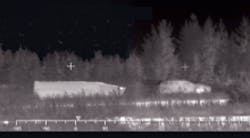IR camouflage lets tanks hide in plain sight
An IR camouflage scheme developed at the armored-vehicle arm of BAE Systems in Sweden lets tanks and other armored vehicles look like Toyota pickup trucks or blend into the background of trees and bushes — at least, that is, to someone trying to locate or target them using IR detectors. The system, named Adaptiv, consists of an array of metal hexagonal plates that attaches to the outside of the vehicle. Each panel has its own semiconductor-based cooling and heating. At the flick of a switch, the panels activate and can be programmed to mimic the IR signature of a variety of different vehicles or natural objects. IR images of vegetation or rocks are available from mission libraries stored onboard that cover desert, urban, and other terrains. The system also has a “grab-and-copy” feature that lets operators copy the thermal signature of a nearby vehicle or the surrounding countryside. Moreover, Adaptiv can be scaled to work on aircraft, warships, and even buildings.
On an Adaptiv system sized for a battle tank, hexagons are about 5.5-in. across. About 450 are affixed to each side of the tank and its turret. Together, they can realistically imitate other vehicles and objects when viewed through IR detectors from a range of 900 to 1,200 ft. The image can be resized to fool observers sitting nearer or farther away. A warship, for example, would not need close-up stealth, so it could be fitted with larger hexagons.
The system carries self-diagnostics, and faulty or damaged hexagons can be replaced quickly in the field. And the hexagons can be made strong enough to provide additional armor protection coverage against small arms. The panels use relatively little electrical power, which the tank can easily provide, especially when standing still.
Although Adaptiv provides camouflage against IR and has been modified to provide cover in other segments of the electromagnetic spectrum, militaries might find it most useful for distinguishing friendly units from hostile ones on the battlefield.
This could be done by making the panels create easily read patterns or alphanumerics, or more subtly, by emitting a specific signature that lets the vehicle stay hidden from the enemy but lets friendly forces identify it.
